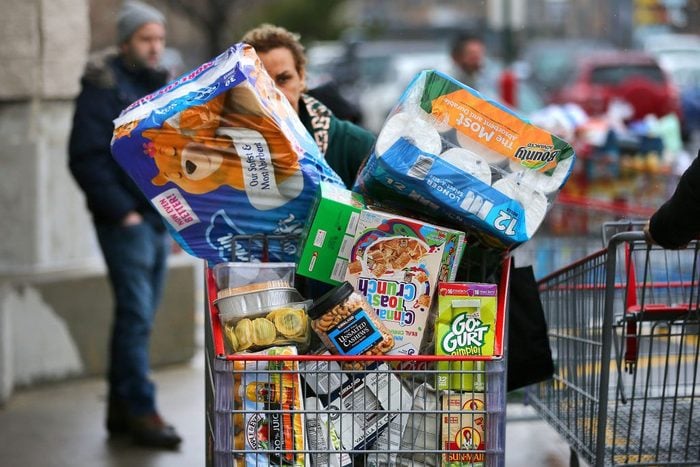
Easy ways to bring down your grocery bill
These days, it’s impossible to ignore the impact of inflation. Prices continue to soar on everything from housing to entertainment to gas and cars. Unfortunately, experts predict that everyday essentials are about to get more expensive. This rings especially true when it comes to food. According to the Consumer Price Index, which measures the cost of goods for the average consumer, grocery prices are up 13.1% over the past year, the largest 12-month increase since 1979.
Phil Lempert, founder of Supermarket Guru and CEO of the Retail Dietitians Business Alliance, says there are some specific factors driving up food prices. For starters, fires and floods caused by climate change are destroying crops around the world. Decreased availability means increased costs, he explains. The price of transportation has also gone up considerably. “Pre-pandemic, it cost about $2,000 to bring a container of food from China to the U.S.,” says Lempert. “Now it’s about $25,000.” Once it arrives, labor shortages contribute to delays in unloading and distribution. There are about 110,000 fewer truck drivers in the country compared with five years ago. That’s a big problem when our food supply relies on long-haul truck transportation.
If you’re trying to figure out how to save money on groceries, you need to shop smart. Start by avoiding shrinkflation—when product sizes decrease, but their prices don’t—a sneaky tactic brands hope you don’t notice. You can avoid shrinkflation with the help of websites like Mouse Print, that advocate for consumers. Get familiar with grocery store secrets and supermarket tricks to conserve cash. And finally, save up to half off your total bill by simply avoiding the steep markup on certain items, including the ones listed below.
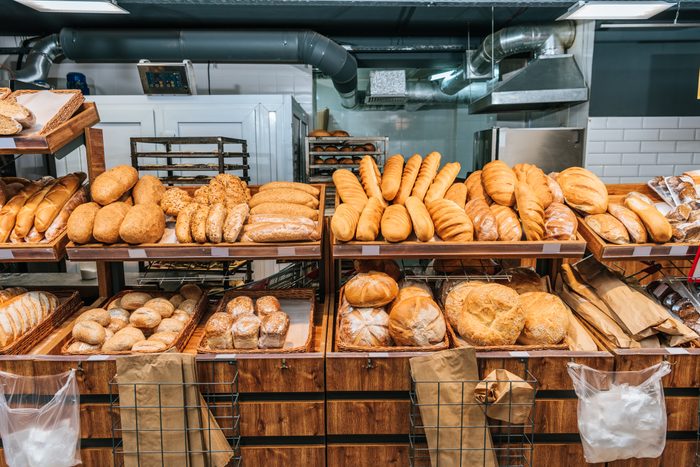
Baked goods
The intoxicating aroma from hot-out-of-the-oven goodies is hard to ignore, but trust us: Keep walking past the bakery. Freshly made cookies, cakes and muffins cost about three times more at the store than they do when you whip up a batch at home, says Alexa von Tobel, founder of financial planning company LearnVest. Unless you’re buying for a special occasion, you probably don’t need the professionally made confections.
What to do instead
“Take time to calculate the trade-off you’re making, so you know if the convenience is really worth it,” von Tobel says. In a time crunch, they might be best, but if you can sacrifice an hour, buy the ingredients yourself (or use a mix from a box). The homemade version will be well worth it. Also check out the bakery’s sale section. If items are about to expire, you can snag them for a bargain and freeze them for later (or eat them that day—we won’t judge!). To shop with confidence, check out the best grocery stores, ranked by value.
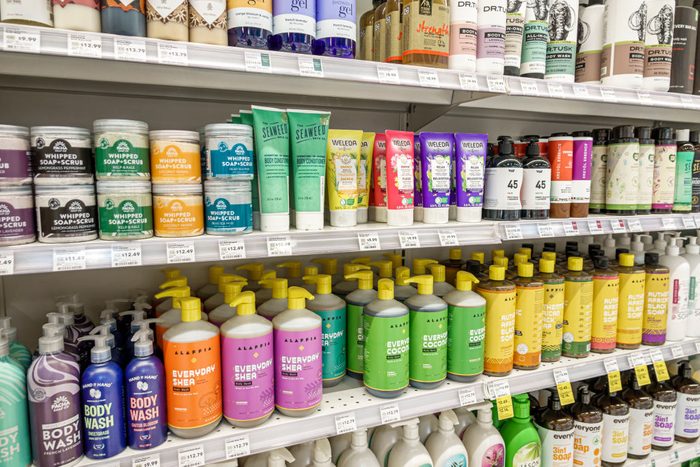
Beauty products
You’ll pay a premium for the convenience of picking up makeup, hair products and other toiletries at the grocery store, says personal finance expert Rachel Cruze, author of Love Your Life Not Theirs: 7 Money Habits for Living the Life You Want. If you buy a 38-ounce bottle of Pantene Pro-V Ultimate Care Moisture Repair Shine shampoo, you’ll pay $9.98 at Sam’s Club or $17.37 at Walmart versus $31.26 at Kroger.
What to do instead
Cruze recommends waiting for a sale or coupon at a drugstore, or heading to a discount supermarket. “It may seem like you’re only saving a few dollars, but it adds up,” she says. Also check out local beauty supply stores; when a shop specializes in an item, they’re able to offer lower prices. If you’re not loyal to any specific brand, dollar stores stock basic skin-care essentials for a steal.
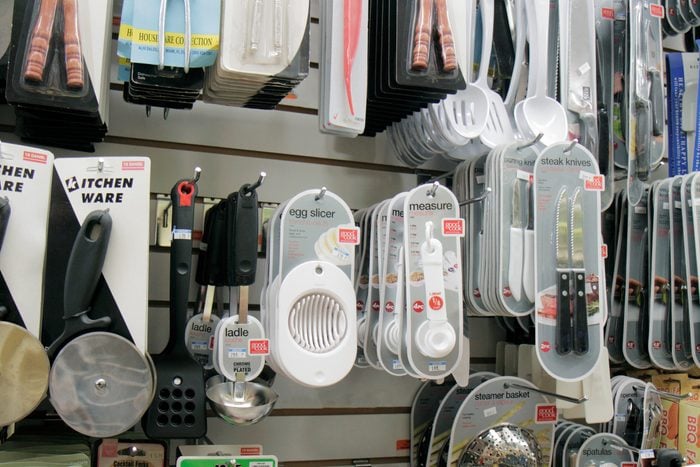
Cooking tools
It might not be until you’re stocking up on supplies that you realize—oh, yeah!—you don’t actually have a rubber spatula to frost the cake you were planning to make. But you’ll have to dish out more dough for the convenience of picking up these tools, even at the grocery stores with the best reputations. Lempert says many nonfood items like these go through a rack jobber, or a vendor that rents space in a supermarket to display and sell goods not traditionally offered there. “There’s going to be a higher markup because you’re dealing through a distributor,” he says.
What to do instead
Avoid grabbing cooking utensils like can openers and graters from the grocery store, and consider making a separate stop on your way home. “Those types of items are usually much cheaper at discount retailers like Walmart,” says Cruze. If you can spare a few days for shipping, you can also try browsing online for the best deal.
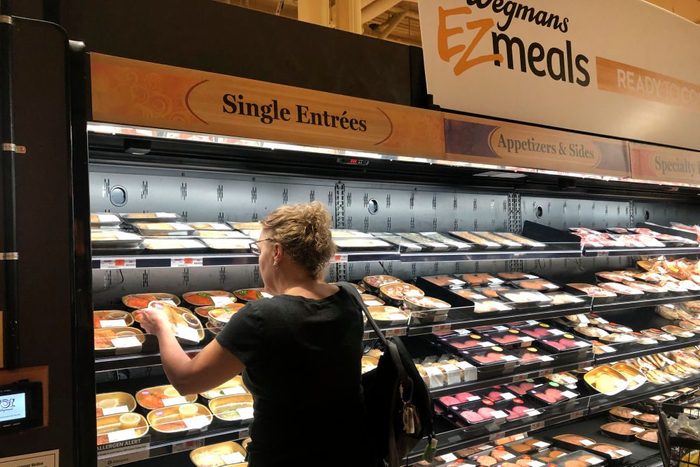
Prepared foods
That tub of potato salad might look tempting for tonight’s dinner, but it’ll cost you. Depending on the dish, you could save up to 90% on items like premade salads, hot-bar items and ready-to-eat meals, says Jill Caponera, a consumer savings expert at Promocodes.com. But price isn’t everything, warns Lempert. He emphasizes comparing ingredients, nutritional information, recipe and quality when deciding what to buy.
What to do instead
You’re at a grocery store, so why not get the ingredients to make it yourself? Sure, it may take more time, but it’s well worth the savings. Plus, buying individual ingredients and keeping them in your kitchen will set you up for success in the long run. If you do a little meal prep and plan in advance, it’s possible to get dinner on the table faster than it would take to get something delivered.
If you’re really set on prepared foods, opt for those that won’t break the bank. A rotisserie chicken is usually the most affordable option, especially if you buy Costco’s famous $5 bird. Also hit up the frozen department. Lempert says when comparing similarly prepared meals, frozen will cost at least 40% less than its fresh counterpart.
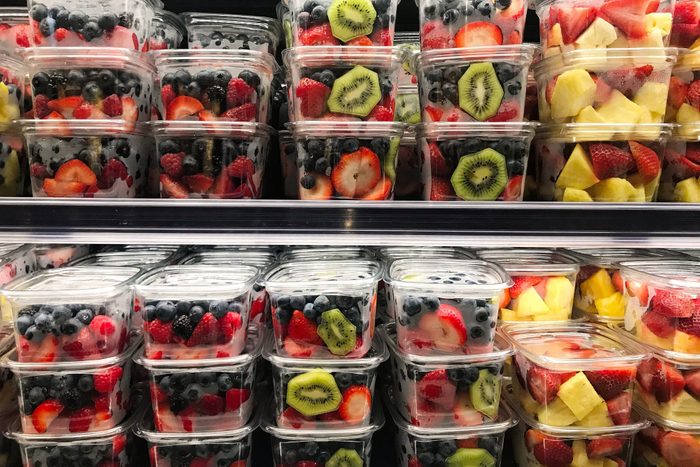
Precut produce
Produce has one of the highest markups because it’s the most perishable, explains Lempert. When you buy chopped or cubed fruits and veggies from the grocer, you’re also paying for the time the staff took to cut it up. For instance, a seeded watermelon typically costs 31 cents to 38 cents per pound, but one pound of fresh-cut watermelon chunks will set you back $6.16 at Wegmans.
What to do instead
“This huge premium can be avoided by buying the product in raw form and preparing it yourself ahead of time—typically for the week,” says Dustyn Ferguson, founder of money-saving site Dime Will Tell. You should also stock up on frozen produce; it’s frozen during peak ripeness, so its flavor and nutrients stay intact. If you pick up frozen fruit during a sale, you’ll save even more. Here are more things money experts tend to buy cheap.
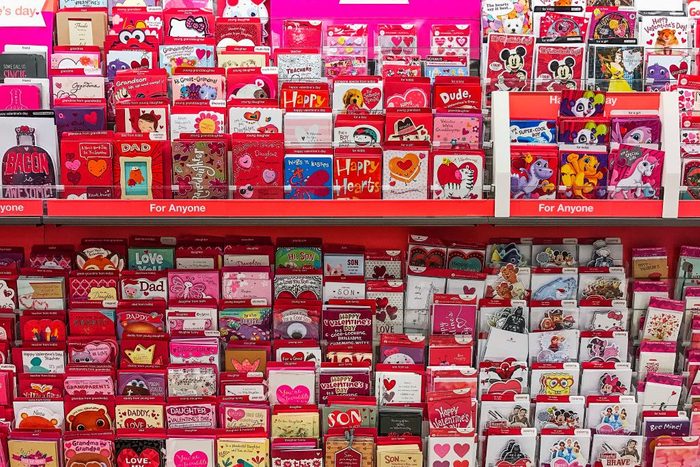
Greeting cards
Picking up a birthday card while you’re buying a cake seems like a no-brainer—until you look at the price tag, which will usually be around $7. “Since grocery stores typically only carry a small number of cards, expect to pay top dollar,” says Caponera.
What to do instead
Head to a dollar store, which usually has a two-for-$1 deal, or better yet, buy a set of occasion-neutral cards in bulk that you can also use for anniversaries, thank-you’s and more. Or go the DIY route by finding a free template online and printing your card at home. Trust us: A thoughtful, one-of-a-kind creation will always be a sweet surprise. And changing even a few of your grocery habits can save you a bundle.
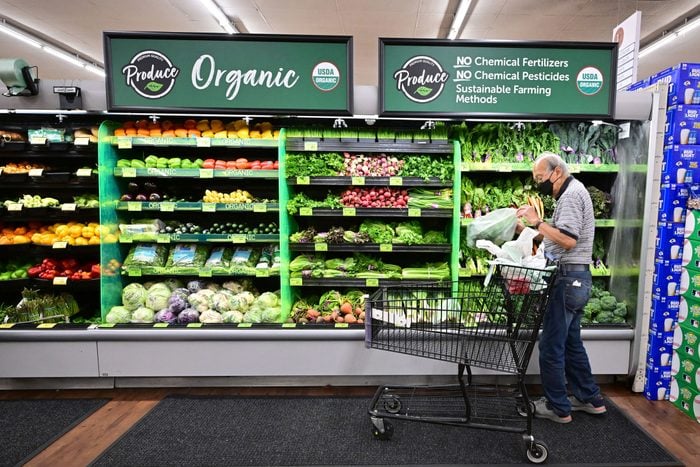
Organic items
Of course you want healthy options. Unfortunately, more often than not, good-for-you food comes at a premium. Your typical supermarket will have a higher price tag for organic products than a store with a health specialty. “For example, something organic at a store like Trader Joe’s will likely be cheaper than the same item at a Shaw’s, simply because the item is in more demand at a Trader Joe’s, which allows the price to be lower,” says Ferguson.
What to do instead
Hit up health-conscious stores like Whole Foods or Trader Joe’s for cheaper prices. Case in point: A loaf of organic whole wheat bread costs $3.99 at Whole Foods, but you’ll pay $6 for Wegmans’s organic brand. Also check out neighborhood farm stands and farmers markets, since buying directly from local vendors may reduce costs. Before you buy, though, decide if organic is even worth it. According to Consumer Reports, certain organic foods are more of a “must” than others. For example, produce like apples, kale and zucchini are high on the list because of potential pesticide exposure.
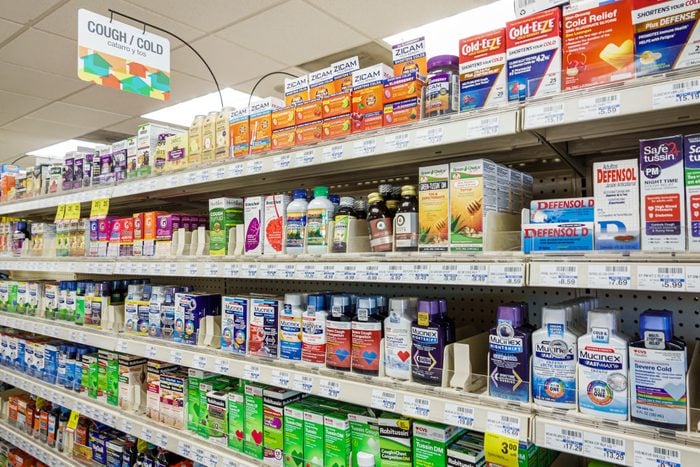
Over-the-counter medications
Avoid the aisle with over-the-counter pain-relief drugs, decongestants and allergy meds. The medications you’ll find at a grocery store can be 15% to 30% more expensive than generic brands at a drugstore or discount store, says Caponera. “More often than not, generic brands are nearly identical to name-brand products,” she adds.
What to do instead
Most grocery stores and drugstores have their own in-house label, and these products will be a better value. This is one of the things grocery stores won’t tell you, and it’s a surefire way to save money. Even better, these generic products are usually located right next to their name-brand counterpart on shelves, so you don’t have to look far. However, compare the ingredients between products to make sure you’re getting what you need before making your purchase.
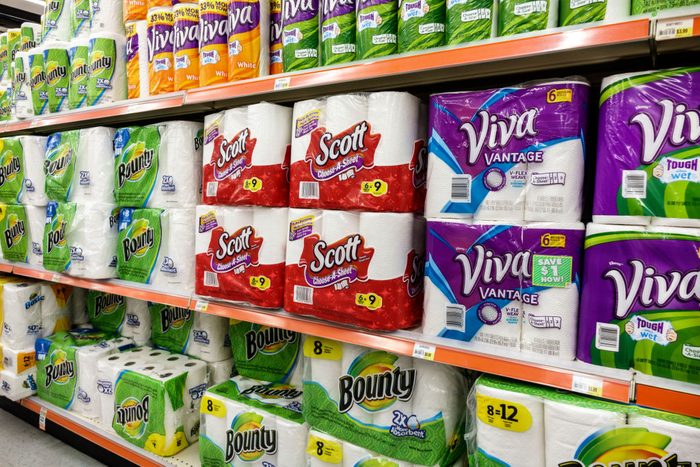
Paper products
You’re going to pay a hefty price to buy disposable nonfood items, such as toilet paper and paper towels. at the grocery store. Snag discounts by cutting coupons the old-fashioned way, or download a store’s app to get notified of current and upcoming sales. Always check unit pricing too. It may take a little math (divide the total cost of the product by the quantity), but it will help you figure out the best grocery deals.
What to do instead
This is when buying in bulk makes the most sense. These items will never expire, so it’s smart to stock up. You’ll find the lowest prices for quality paper goods at wholesale clubs rather than at grocery stores. For instance, a 12-pack of Costco’s Kirkland paper towels costs $22.99, and you’d pay about the same at Kroger, but for half the amount of product. For smaller quantities, the dollar store often stocks essentials from name brands like Bounty, Charmin and Hefty. But if you’re at the supermarket and you can’t wait, here’s the cheapest day of the week to buy.
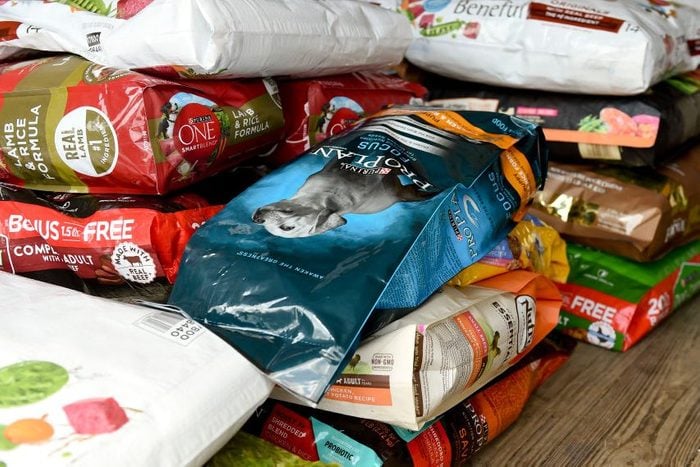
Pet food
For the best deal, don’t get your dog’s or cat’s meals at the same place you buy food for the rest of your family. “You’ll likely only find a half aisle at most dedicated to pet food at your local grocery store, making the selection more expensive,” says Caponera.
What to do instead
Check warehouse clubs like Sam’s Club and Costco, or online retailers like Amazon, for the best price, Caponera says. One can of Purina Friskies cat food costs 90 cents at Kroger, but you’ll pay about 70 cents per can if you buy the same brand in bulk on Amazon. Another incentive for shopping on Amazon is the “subscribe and save” program, which offers additional discounts (like 40% off the Purina cat food) if you set up a recurring order. You can unlock big savings on items you regularly use by signing up for auto-delivery, not to mention save on time, since you’ll never run out. Bonus: You can choose how often it gets sent, as well as skip an order or cancel at any time.
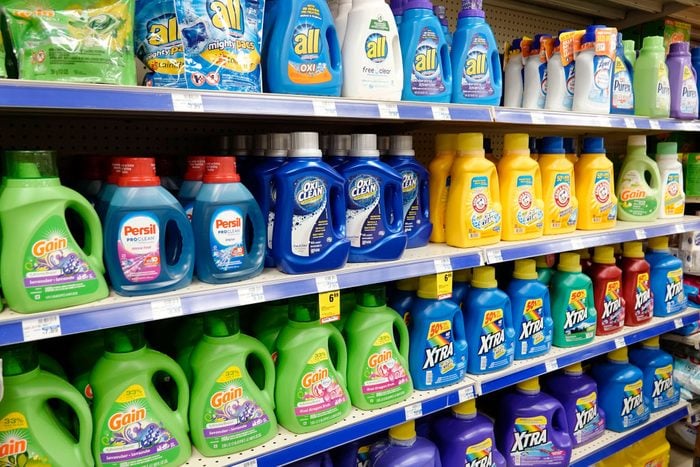
Laundry detergent
“When you compare pricing of bulk detergent versus the size you’ll find in the grocery store, it’s a no-brainer,” says Caponera. Expect to save 9 cents on every Tide Pod by buying in bulk at Costco, or save money by buying regular-size detergent at Target, Walmart or Amazon—preferably with a coupon.
What to do instead
Buying in bulk will yield the highest savings. If you don’t go that route, always check a store’s grocery shopping app or a budget app, which may give you access to exclusive coupons and sale prices. Also join loyalty reward programs for special deals and discounts.
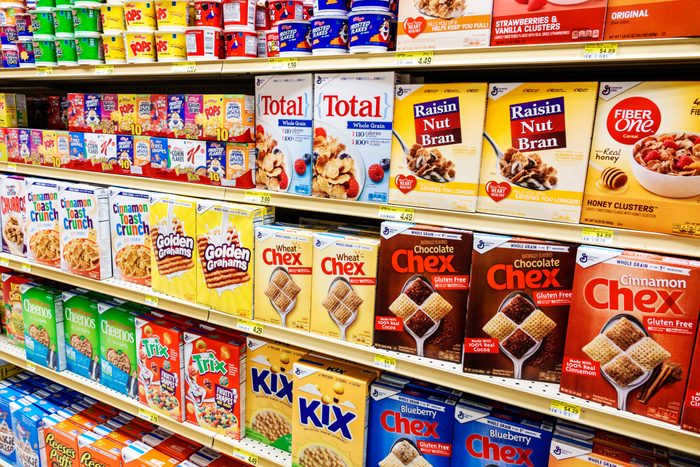
Cereal
Cereal is a perennial pantry staple. It’s a quick and easy breakfast loved by kids (and adults), and you probably mindlessly throw it in your cart during shopping trips. But it’s a surprisingly bad buy at the grocery store. According to the Consumer Price Index, the price of cereals increased 15% over the past year, so it has never been more important to find money-saving options. Find out why you shouldn’t buy cereal at Costco.
What to do instead
If you don’t want to give up your favorite box of Kellogg’s, you’ll pay less for name brands at discount grocers like Aldi. But if you can tear yourself away, do it. Lempert says you can save up to 25% by buying a store’s in-house cereal label. They usually look and taste the same too—and have nearly identical ingredients and nutritional content.
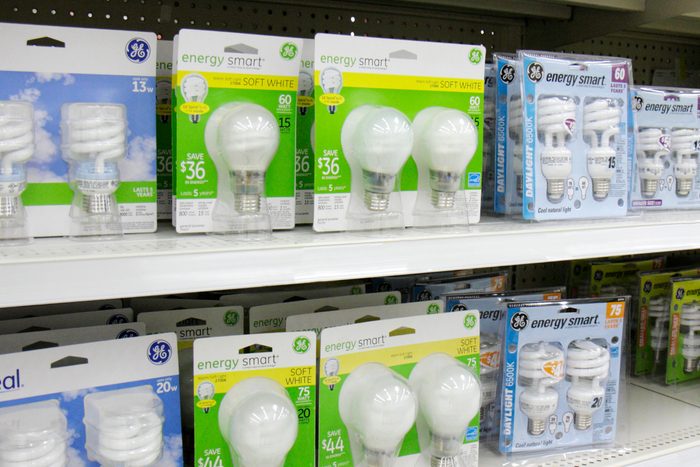
Light bulbs
Light bulbs usually have a 60% markup in supermarkets compared with other stores, says Caponera. Try buying in bulk (no expiration date!), or find them at a discount shop like a dollar store, she suggests.
What to do instead
Shop online. Light bulbs are among the things you should always buy on Amazon. You can get a 24-pack of energy-efficient 60-watt LED bulbs for $23.99 there. The price amounts to just $1 per bulb, which is a lot less than you’ll pay at a grocery store. At H-E-B, a single 60-watt bulb costs $4.10, while a similar version at Wegmans will set you back $4.42. Here are even more things you can buy on Amazon for less than a dollar.
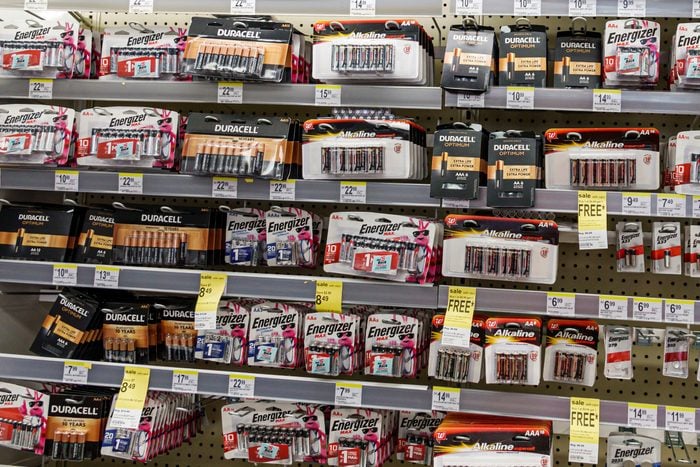
Batteries
As with other home goods, you’ll pay for convenience if you pick up batteries on your grocery run. You can get those at the dollar store for pennies on the dollar. Since most batteries have a 10-year shelf life, it’s smart to stock up on them for emergencies.
What to do instead
Buy batteries in bulk at a discount warehouse club. Also check out Amazon for similar savings. The shopping behemoth makes its own version under its Amazon Basics brand. You can snag a 48-count package of AA batteries for $13.14—you’ll pay close to 50% more for the same amount of name-brand Energizer batteries. And you don’t have to worry about quality: These batteries have more than 390,000 glowing five-star reviews on Amazon. The deal for AAA batteries is even better: Get 100 Amazon Basics AAAs for a mere $22.99. That’s almost half off what you’d pay for an off-brand at Target!
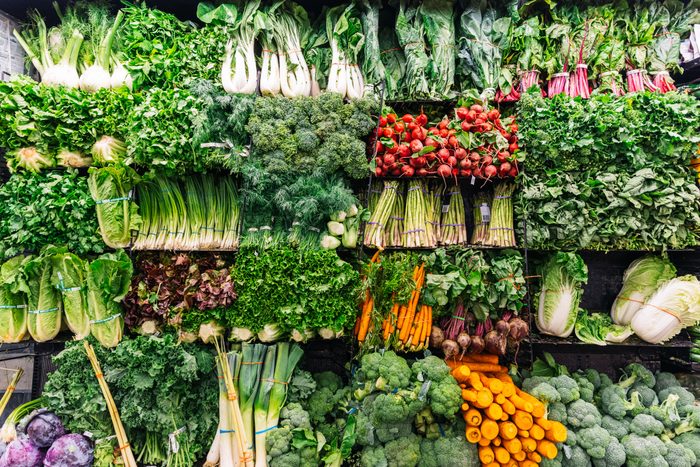
“Pretty” produce
You know the saying “Don’t judge a book by its cover”? This applies to certain foods too. Stores know that shoppers prefer “pretty” fruits and vegetables to produce that is oddly shaped. And while those ideal specimens are marked up, you might be able to find less-perfect-looking options for a fraction of the cost.
What to do instead
Ignore aesthetics. “An increasing number of supermarkets, including Walmart, sell ‘ugly’ produce at cut-rate prices—think 50% off,” says von Tobel. They might have a bruise or a funny shape, but they’ve got just as much flavor and nutrients as their better-looking counterparts. There are also a crop of new subscription services, including Misfits Market and Imperfect Foods, that aim to reduce food waste by providing low-cost options for unattractive produce. If you’re willing to overlook appearances, these subscription boxes are some of the cheapest ways to order groceries online.
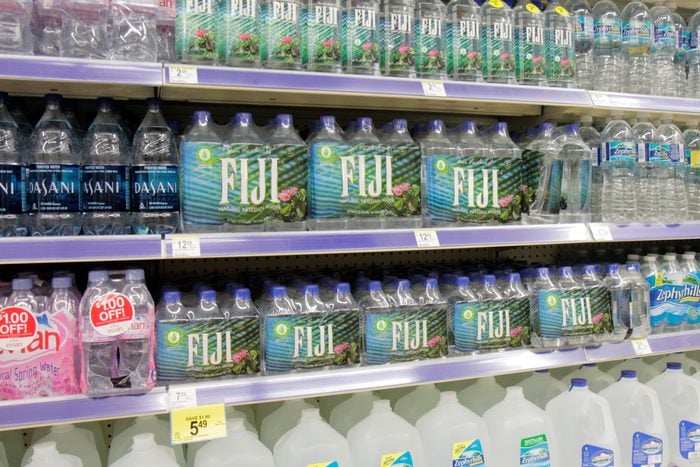
Bottled water
Bottled water is by far the most overpriced item in a grocery store. According to a report from Harvard University, it’s about 3,000% more expensive per gallon than tap water. The study also debunks the myth that bottled water is better for you: “Bottled water generally is no cleaner, or safer, or healthier than tap water. In fact, the federal government requires far more rigorous and frequent safety testing and monitoring of municipal drinking water.” If you need even more reasons to ditch bottled water, do it for the environment. At least 14 million tons of plastic end up in our oceans every year.
What to do instead
The easiest solution is to buy a reusable water bottle. (They even make smart versions, if you prefer.) The Earth Day website reports that Americans purchase about 50 billion water bottles per year, averaging about 13 bottles per month for every person in the United States! By using a reusable water bottle instead, you could save an average of 156 plastic bottles annually. Want to be extra safe? Buy a filtration system for around $30 and attach it to your faucet.
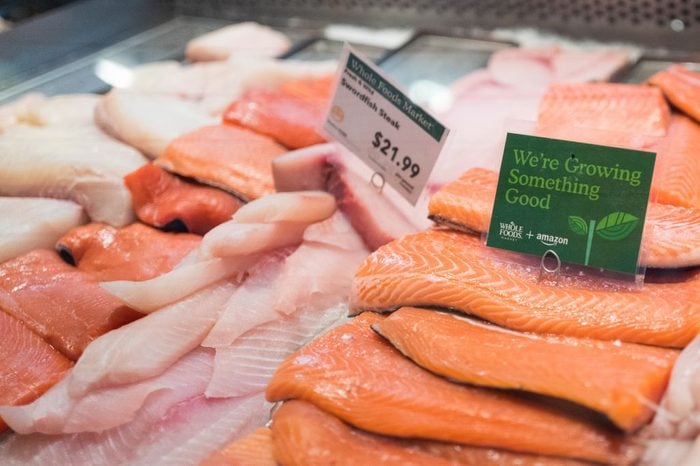
Fresh seafood
Don’t be fooled by the fresh seafood counter. Fish is always frozen when it arrives at the supermarket; it’s then thawed out and presented on ice. So it may appear like you’re splurging on a fresh catch, but it’s actually a bait and switch, and one of the major shopping mistakes that wastes money.
What to do instead
The frozen version is the superior choice. If you buy fish directly from the frozen-food department, you can probably save 35% to 40%, says Lempert. He also says there’s a good chance it’s a better product anyway because it hasn’t already been defrosted by the distributor, then rechilled by the grocery store. Fishermen are also now vacuum-sealing fish immediately after they’re caught to improve quality even more.
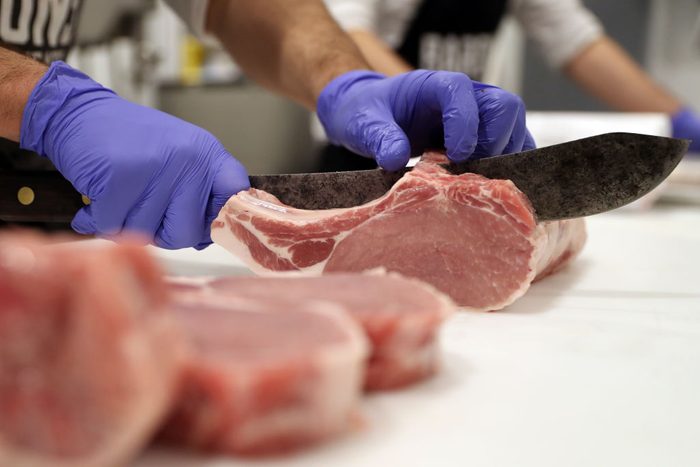
Fresh meat
The markup on meat depends on the type, cut and quality, but if you’re at the deli or butcher counter, expect to pay a premium. Any service department that involves human beings (who have to be specially trained, to boot) will have higher markups, explains Lempert. Labor and additional costs for specialty equipment also create higher expenses and drive up prices.
What to do instead
“If you’re buying frozen meat versus fresh meat, you can save anywhere between 25% and 35%,” says Lempert. Meats are packed and frozen at the peak of freshness, so you aren’t losing any quality, he adds. Also look for prepackaged meat that’s on sale, stock up when you find a good deal and freeze the extra servings for later.
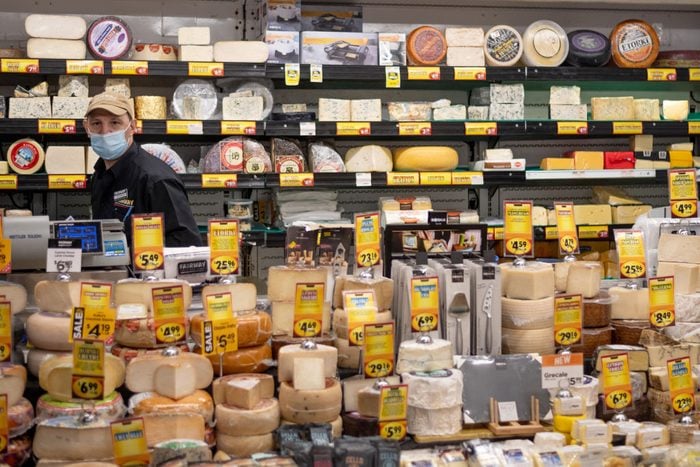
Fancy cheeses
Fromage fiends can get their favorite variety prepackaged in the dairy department, sliced in the deli or fresh from specialty displays. The FDA regulates dairy, which means cheese makers must follow specific rules to maintain a certain quality. In fact, there are 75 different federal criteria that control things like ingredients permitted, manufacturing and the production process. That means regardless of the brand or packaging, you’re guaranteed a certain standard—whether it’s Swiss, cheddar or mozzarella—despite the supermarket myths you might have heard.
What to do instead
Forgo the deli and skip any overly decorated artisanal blends. “It’s really the same product, just sold in different parts of the store,” Lempert says. You’ll save about 40% to 45% in the dairy department on no-frills brands and any assortment wrapped in plain plastic, he notes.
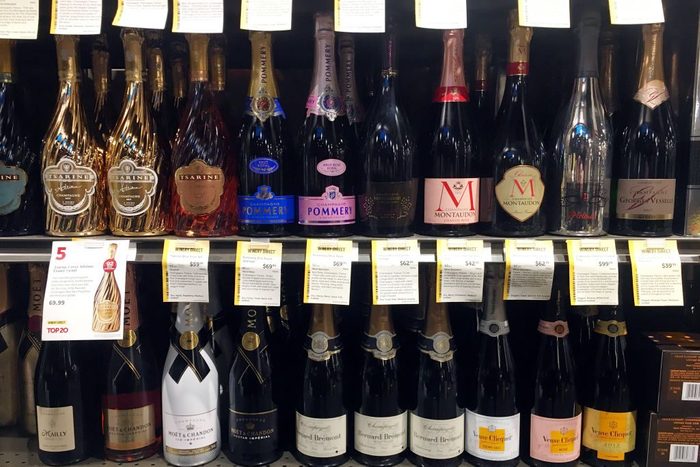
Alcohol
Consider it a sign of the times, but inflation doesn’t seem to be slowing down liquor consumption. In fact, online alcohol sales from grocery stores are expected to reach nearly $2 billion in 2022. Even so, you can expect about a 25% markup if you want to pick up your favorite booze while shopping for your weekly provisions.
What to do instead
You can score lower-priced libations at a warehouse club, but Lempert suggests going to a retailer that specializes in alcohol, such as Total Wine & More. Stores that focus on just one type of product are buying in a higher volume, which brings down prices. You’ll also have a much larger variety, so it’ll be easier to find that limited edition White Claw flavor or discover an amazing new locally sourced wine.
Additional reporting by Marissa Laliberte.
Sources:
- Phil Lempert, founder of Supermarket Guru and CEO of the Retail Dietitians Business Alliance
- Alexa von Tobel, founder of LearnVest
- Rachel Cruze, personal finance expert and author of Love Your Life Not Theirs: 7 Money Habits for Living the Life You Want
- Jill Caponera, consumer savings expert at Promocodes
- Dustyn Ferguson, founder of Dime Will Tell
- Consumer Reports: “Which Food to Buy Organic (and How to Spend Less When You Do)”
- U.S. Bureau of Labor Statistics: “Consumer Price Index Summary”
- Harvard University: “Top Three Reasons to Avoid Bottled Water”
- Earth Day: “Fact Sheet: Single Use Plastics”
